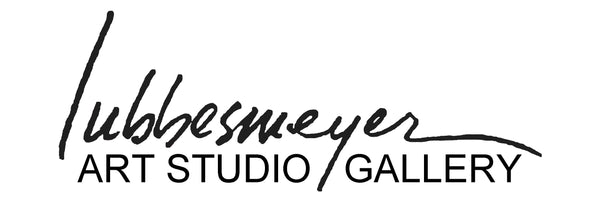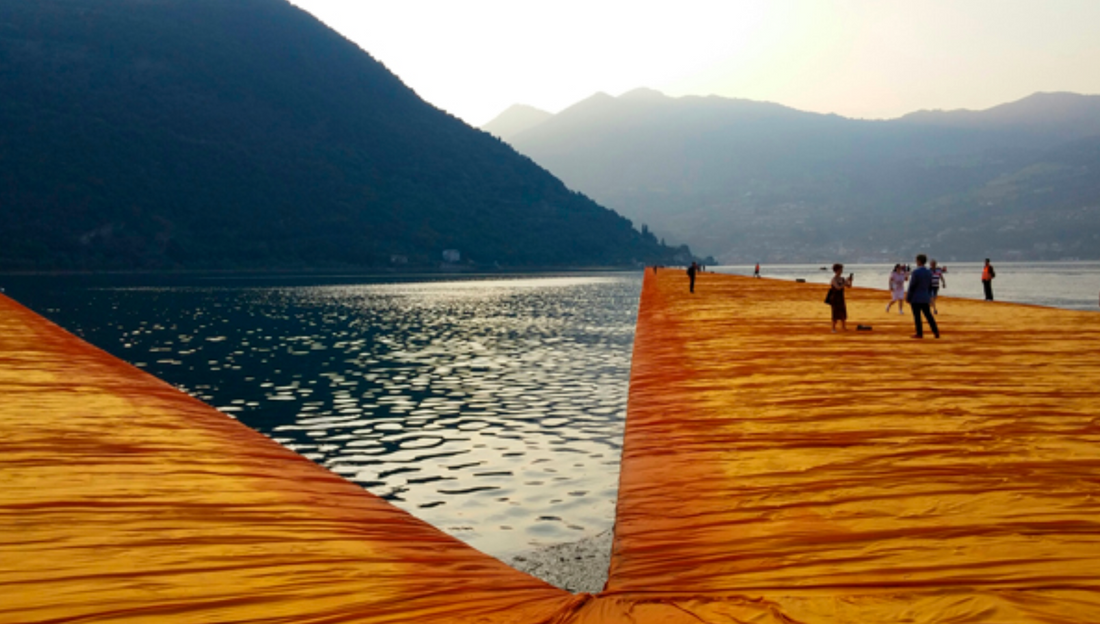Earlier in the year, a friend had learned of an upcoming Christo and Jeanne-Claude art installation that was going to be open for two weeks in June on a lake in northern Italy. Instead of wrapping islands, trees, or buildings in fabric, Christo was going to create a fabric covered, 3-kilometer-long floating walkway called “The Floating Piers”. Shortly after my friend read the article in the New York Times, she decided to go and invited my partner and me (Lisa) to join her. Until then, I’d always assumed taking in Christo’s work would be something I would do only through pictures. So when given the invitation to go, I knew this would be a trip of a lifetime.
My first impression of the piers came in response to being among the enormous crowds. Initially, I felt anxious and most of my attention was focused on not walking into the people around me. The crowd was hemmed onto one path, and we mostly had to move in the same direction, at the same pace. To add to the feeling of being overwhelmed, the average temperatures were above 90 degrees and very humid, and there was no protective shade to rest under. Despite these conditions, with the exception of late night to early morning, the piers were nearly always full.
Since we were staying nearby, I had the luxury of walking the “Floating Piers” several times and at different hours of the day and night. After my initial adjustment to the crowd, whenever I joined the thousands of others walking the pier, that’s when I could feel the power of the art. Even though there were hours-long waits even to step on the piers, relentless heat, a lack of food and water, and long distances traveled (there were very few rooms available within hours of the site), most everyone walking the piers appeared relaxed and happy. I was astonished, thinking it would have been understandable if everyone’s tempers boiled over.
Instead, we witnessed a spectrum of joyful activities. Some couples became engaged and others got married. There were people of many different cultures and nationalities walking and sharing conversation with each other. Families of multiple generations held hands while they made their way across the lake and around the islands. We saw a man in tears as he lifted his wife out of her wheelchair so they could sit together, feeling the fabric and the gentle rolling of the walkway underneath them. And there were adults doing handstands with children, laughing and smiling together even though they just met.
It was one of the most moving art pieces I’ve ever experienced. I couldn’t help but think about how the bringing together of so many people was the true purpose of this latest Christo and Jeanne-Claude installation. Even if this wasn’t the intended purpose for their concept, I imagine Christo felt pleased by what he saw and thought his wife would have enjoyed it too.
Caption: The “Floating Piers” were open for 14 days. An estimated 90,000-100,000 people a day walked the piers.
Caption: “The Floating Piers” from the top of the island, Monte Isola.
More About Christo’s “Floating Piers”
The “Floating Piers” installation was conceived in 1970 by the husband and wife collaborating duo, Christo and Jeanne-Claude. Even though Jeanne-Claude passed away 7 years ago, after thousands of work hours, and millions of self-funded dollars, Christo was able to bring the installation to fruition. It existed for only two weeks and was free to anyone who wanted to visit. The piers were built as a continuous floating walkway crisscrossing the lake. The hollow polyethylene blocks were linked and layered first with felt and then covered with a saffron-colored fabric that changed tone along with the light of the day. The continuous pier connected the mainland to the island of Monte Isola, across to a smaller island, and back again. The pier was about 50 feet wide and floated 12 inches above the water. Before The Floating Piers opened, the estimate was 40,000 people might walk it every day. Instead, there were 90,000-100,000 people visiting each day. After the “Floating Piers” closed, the installation was taken apart, and pieces were either recycled, repurposed or sold to help fund the installation.


You are so fortunate to have had this experience.
“A lifetime experience” How very beautiful to do the walk with those of like minds. Such energy!
Thank you for sharing this. I too, will share this post with others.
Sharon Tillinghast
Lisa on September 30, 2016 at 12:09 PMThank you for reading and sharing my story of the ‘Piers’. I agree Sharon, I was extremely fortunate, especially given there were relatively few of us who were able to see it. I will do my best to express my gratitude to Christo and Jeanne-Claude by honoring them in my own life and work.
What a trip! Love the photos, especially the last two. Thanks for sharing your journey with us.
Lisa on September 30, 2016 at 12:14 PMI live very near to New York City and so was fortunate to go to Christo’s The Gates in Central Park. I really was not prepared to be as emotionally affected as I was. Even with the crowds that were there it was a truly reverent and emotional experience. I can only imagine how wonderful the Walk on Water was. So glad you could experience it
Lisa on September 30, 2016 at 12:21 PMI’m so glad you shared your experience of The Gates, Margaret. While walking the ‘Floating Piers’, I wondered if the reactions to all of Christo’s and Jeanne-Claud’s installations are universal? If so, is it due to the scale, the marriage of the art with the landscape, or the accessibility for so many different people? I know I will be pondering this for some time. And a related note, thank you Margaret for your visits and conversations about your experiences with art. Your stories and enthusiasm enriches our lives.
this is simply amazing!!! What held the fabric-covered blocks 12″ above the water? I would think with so many people on it at one time, it would sink. I am happy that you were able to witness this truly amazing art.
Lisa on September 30, 2016 at 12:37 PMA great question Anne. Even though I got to see it in person, it was still hard to believe the materials and the construction could keep that many people afloat, even when the artists’ projection for visitors was exceeded by 150 percent! Anyway, to answer your question, the fabric was laid over felt that was about an inch thick. Those two materials were laid over large, hollow polyethylene blocks that linked together a bit like legos. The engineering and manufacturing of this installation was awe-inspiring, and made even more wonderful considering all of it was recycled or repurposed in some way. There’s a wonderful website about the “Floating Piers” which includes some amazing photos and videos about the project: Christo and Jeanne-Claude’s Floating Piers
thank you for sharing a really unique and mind expanding experience
Lisa on September 30, 2016 at 12:42 PMIt will be interesting to see how this impacts your art.
I agree Linda. Experiences like this seem to have a gestation period before they come out through our art. Sometimes it’s a very direct and obvious response, and sometimes it takes years and it’s very subtle. While at the “Floating Piers” I learned that Christo and Jeanne-Claude often like to give some type of memento of their work. In this case, it was a small swatch of the fabric. When I got a piece, my heart fluttered with the possibilities. As I often say, we’ll see…
Thank you, Lisa, for bringing Christo’s vision to us. It’s interesting that you were able to witness so many people moved by Christo’s art; it speaks to the need for art all over this world! (Great pics, too, Lis)
Lisa on October 4, 2016 at 12:02 PMYou said it very well Joni. Though we may be biased, we feel art is a universal form of expression that represents the essence of the human experience. In a world where we seem to be taking for granted what it means to be human, the preciousness of it, we’re glad to know there are a few things that can still remind us of who we are and why we’re here. This is one of many things I saw in the ‘Floating Piers’, and will do my best to remember, and carry it through in our work.
What a great description of the art and the experience. Art touches the heart–and the mind and the soul–of the artist and of the viewer. Thank you for this sharing!
Lisa on October 4, 2016 at 12:10 PMYou’re welcome Ellen. It was a privilege that I got to see this installation, and so I feel it is my duty to share my experience with others. Thank you for sharing your thoughts about what art means to you (and others). As artists, Lori and I hope that all people can know how important (consciously or subconsciously) art is to one’s spirit. Whether it’s made from sticks and mud and has a function, or it’s a masterpiece hanging in a museum, art ties us all together, in our uniqueness and our commonalities.